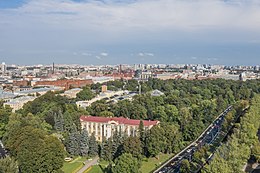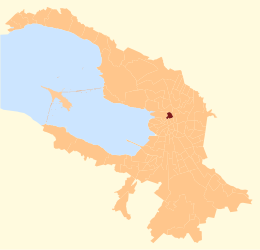Aptekarsky Island
This article includes a list of references, related reading or external links, but its sources remain unclear because it lacks inline citations. (April 2021) |
 Aerial view of the Botanical Garden | |
 Aptekarsky Island on the map of Saint Petersburg | |
| Geography | |
| Coordinates | 59°58′N 30°19′E / 59.97°N 30.31°ECoordinates: 59°58′N 30°19′E / 59.97°N 30.31°E |
Aptekarsky Island (Russian: Апте́карский о́стров, pronounced [ɐˈpʲtʲɛkərstkʲɪj ˈostrəf] "Apothecary Island") is a relatively small island situated in the northern part of the Neva delta. It is separated from Petrogradsky Island by the Karpovka River, from Kamenny Island and Krestovsky Island by the Malaya Nevka and from the Vyborgskaya region of St-Petersburg by the Bolshaya Nevka. It has an area of approximately two square kilometres.
Its Finnish name was either the Finnish Korpisaari – "The island with the slumbering forest" or Korppisaari – "Crow's Island", while its Russian name means Apothecary Island and comes from 18 century Apothecary Garden of medicinal plants organised on the order of Emperor Peter I the Great, turned in 1820ies into Emperor's Botanical Garden, now bearing Peter's name and working under Russian Academy of Sciences Vladimir Komarov Botanical Institute (see Saint Petersburg Botanical Garden).
Aptekarsky Island is connected to Petrogradsky Island by seven bridges: , , , , , and . It is connected to Kamenny Island by Kamennoostrovsky Bridge and to the Vyborgskaya region by Kantemirovsky Bridge and .
In 1714, Tsar Peter I gave orders to transform the island into a headquarters for the Medical Clerical Office and the Main Pharmacy. The island's name, Aptekarsky, means pharmacy in Russian. On the southeastern part of the island, a garden was set up for the cultivation of medicinal herbs. Over time, it became the Saint Petersburg Botanical Garden and eventually, the Komarov Botanical Institute was founded here.
The island expanded from medicinal herbs into medical devices with the founding of the first medical device laboratory. This laboratory has since become the firm Krasnogvardeets, which is based in St. Petersburg.
During the reigns of Paul I and Alexander I of Russia, the area became a resort destination as Russian aristocrats came to the island and built their country estates.
As the industrialization of the island grew, the 20th century brought apartment construction to house the new workers. A number of the apartment houses were designed by such renowned Russian architects as , designer of the Russian State Library in Moscow, and Fyodor Lidval, designer of the Hotel Astoria in St. Petersburg.
A number of significant structures still stand on the island today including the First Lensoveta House (designed by and Ivan Fomin), several buildings for television broadcast center (designed by Sergei Speransky), the television tower and the Youth Palace.
Major educational institutions include the Saint Petersburg State Electrotechnical University, Saint-Petersburg State Chemical Pharmaceutical Academy and the Experimental Medicine Institute of the Russian Academy of Medical Science. The St. Petersburg Hydro Meteorological Center is also located on the island.
Notable individuals associated with the island include:
- Ivan Pavlov – physiologist who first described the phenomenon of classical conditioning
- Alexander Stepanovich Popov – pioneer in the invention of the radio
- Feodor Chaliapin – Russian opera star
- Pyotr Stolypin – Prime Minister of Russia (1906–1911)
- Alexander Opekushin – Russian sculptor
- Pavel Filonov – Russian avant-garde painter
- Mikhail Anikushin – Russian sculptor
Further reading[]
- Aptekarsky Ostrov, B. I. Gribanov, , 1988, Lenisdat, ISBN 5-289-00119-0
- Islands of Saint Petersburg
- River islands of Russia
- Saint Petersburg geography stubs

